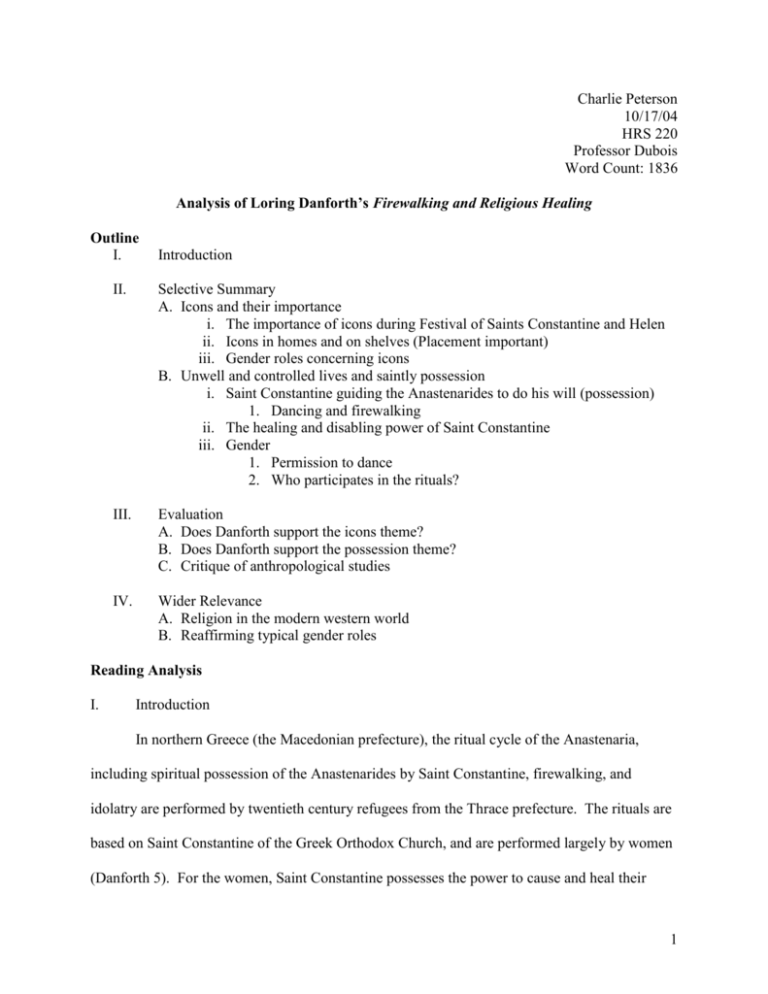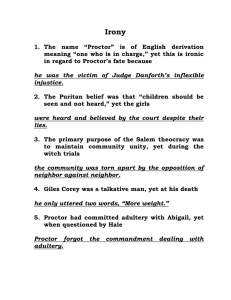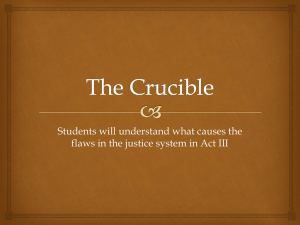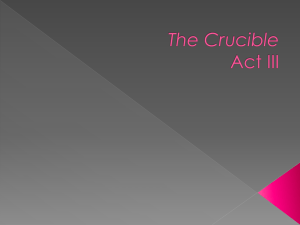Selective Summary
advertisement

Charlie Peterson 10/17/04 HRS 220 Professor Dubois Word Count: 1836 Analysis of Loring Danforth’s Firewalking and Religious Healing Outline I. Introduction II. Selective Summary A. Icons and their importance i. The importance of icons during Festival of Saints Constantine and Helen ii. Icons in homes and on shelves (Placement important) iii. Gender roles concerning icons B. Unwell and controlled lives and saintly possession i. Saint Constantine guiding the Anastenarides to do his will (possession) 1. Dancing and firewalking ii. The healing and disabling power of Saint Constantine iii. Gender 1. Permission to dance 2. Who participates in the rituals? III. Evaluation A. Does Danforth support the icons theme? B. Does Danforth support the possession theme? C. Critique of anthropological studies IV. Wider Relevance A. Religion in the modern western world B. Reaffirming typical gender roles Reading Analysis I. Introduction In northern Greece (the Macedonian prefecture), the ritual cycle of the Anastenaria, including spiritual possession of the Anastenarides by Saint Constantine, firewalking, and idolatry are performed by twentieth century refugees from the Thrace prefecture. The rituals are based on Saint Constantine of the Greek Orthodox Church, and are performed largely by women (Danforth 5). For the women, Saint Constantine possesses the power to cause and heal their 1 troubles, and through the rituals of the Anastenarides, gain increased control over their problems (5). Given the nature of this anthropological study, I considered Danforth’s use of direct quotations, photographs and his descriptions of the actions of the Anastenarides as primary sources (especially in chapter one), as well as the direct conclusions he drew in chapter three. I did not consider his secondary analysis in chapter two. II. Selective Summary Icons and their Importance In Danforth’s anthropological treatment, he reported that idolatry was integral to the rituals of the Anastenarides. During the Festival of Saints Constantine and Helen, icons played a prominent role in the Anastenaria rituals. The icons of Saint Constantine and Helen were often kissed and nearby candles would be lit in their honor (11). As the ceremony progressed, the leader of the Anastenarides would pass the icons to the dancing Anastenarides and the participants would dance with the icons (13). In the tradition of Greek Christian orthodoxy, icons were considered to be the most powerful link between human beings and God and the Saints (70). The Anastenarides believed that “the icons of Saints Constantine and Helen …possess[ed] supernatural powers and the ability to perform miracles” (71-72). Because of their power the icons were treated with much reverence and respect during the festival, and throughout the year. Throughout the year, the Anastenarides placed much importance upon the physical location of the icons. The location of icons, such as on a shelf or near a window were common conversation topics among the Anastenarides. In one instance, the leader of the Anastenarides, Yavasis, instructed Maria “that she should put the icon in a bright sunny place so it could look out the window” (26). Because the icons were believed to possess the spirit of the Saints 2 themselves, it was important to treat the icons with respect and dignity. Yavasis said to Maria, “‘wherever the icon is, it should be on a shelf. It’s a guest in your house. It should have a place to sit down; it should never be hung from the wall’” (27). The icon shelf was necessary so that the Saints would have a place to rest in the homes of the Anastenarides (43). If it pleased the Saints to have their icons placed near a window and on a shelf, the Anastenarides would oblige (42). The treatment of icons varied by gender. Women seemed to be primarily responsible for the daily care of the icons such as placing them in the homes (27,42), taking the icons to be repainted (26) and washing the simadia (67). The care of the icons provide the women some control over their daily troubles as the icons were possessed by Saint Constantine, and he controlled the health of the women (5). However, during the Festival of Saints Constantine and Helen, women were not allowed to remove the icons from the icon shelf during the rituals but it was acceptable for other men besides the leader of the Anastenarides to do so. During the 1976 Festival of Saints Constantine and Helen, Danforth witnessed Mihalis Kitsos approach the icon stand and remove the remaining icon and dance across the hall floor with the icon (13). It was this action that prompted a slight controversy amongst the Anastenarides. To some, his action was seen as insulting to the leader Yavasis, whereas other Anastenarides seemed to think it was justified because he was a man (24). Possession and the Unwell The lives of the Anastenarides were intertwined with Saint Constantine’s possession of their bodies, especially during the Festival of Constantine and Helen. During the festival, Saint Constantine possessed the bodies of the Anastenarides and compelled them to dance (11). Dancing was “an expression of [the Anastenarides] relationship to Saint Constantine” (5). The 3 festival culminated with firewalking, as the possessed Anastenarides danced across burning coals (19). Suddenly an Anastenarissa in a blue dress, holding an icon high above her head, ran across the fire. Cries of disbelief and amazement rose from the crowd. Other Anastenarides entered the fire, running and dancing back and forth across the bed of coals, stirring up showers of sparks and glowing embers. (19) Saint Constantine gave the Anastenarides the ability to dance across the burning hot coals by possessing their bodies (20). “When I’m on the fire, the spirit guides me, and the power. On the fire I don’t exist as Mihalis anymore, but I know what’s happening around me.” The Anastenarides’ power to walk on fire comes from being possessed by Saint Constantine (74). Just as the saints mediate the relationship between God and human beings, rendering the supernatural power of God more accessible to people, so the Anastenarides mediate the relationship between the saints and human beings, rendering this supernatural power even more accessible. (74) The Anastenarides channeled the power of the saints through their bodies, compelling them to dance involuntarily and walk across fire. The Anastenarides saw themselves as hosts for divine power. Saint Constantine has the supernatural ability to “cause and heal a wide variety of illnesses” (5). The saint uses his powers to heal the illnesses of his believers, as well as cause sickness in those that disrespect him. In chapter one, Danforth provided a variety of stories of Saint Constantine using his healing powers. Saint Constantine helped Maria Kondou cope with the loss of her nephew and her anxiety attacks (29). Saint Constantine helped a man named Nikos deal with his difficulties while living abroad in Australia (34). Despite the protection and healing powers Saint Constantine provided his believers, he was known for his supernatural ability to cause illness (82). What the saint requires to reverse this turn of events is to right any broken promises to him and to “submit to his will by promising to believe in the Anastenaria and 4 serve him faithfully” (83). By following Saint Constantine’s instructions, the Anastenarides eventually overcame their troubles and illnesses. Gender played an important role in the Anastenaria tradition of possession by Saint Constantine. Most of the Anastenarides were women (68). The ritual possession of these women empowered these women to deal with their social, mental and physical problems. The Anastenarissa Maria Kondou found that the only cure for her anxiety was to light incense and dance. “I was overcome with anxiety – the same anxiety I feel when I dance. All I could think about was going home and lighting my lamp. I went home and lit it, and then I danced. My husband tried to stop me because he thought I’d get more upset, but I just pushed him away. After I danced for a while, I cam to and lit some incense. I felt better then; I calmed down. My worries passed with the help of Saint Constantine.” (29) The women often had marginal power in their male-dominated society. By being possessed by Saint Constantine, who controlled illness and healing, the women gained control over their mental and physical well-being. As Anastenarissa, women gained control over their lives within the framework of the Anastenaria. Within this sphere of control, the women “are able to act as men and in that way gain an increased sense of power and control over their lives without actually challenging the legitimacy of an official ideology of male dominance” (5-6). Despite the Anastenarissa’s ability to transcend gender roles, they still need permission from men prior to gaining control of themselves. For instance, when Maria’s “legs first started to tremble, Yavasis came over to her and asker her if her husband would give her permission to dance. Without his permission, Yavasis couldn’t give her a simadi or let her dance” (27). Women still needed permission from men to actively participate in the rituals of the Anastenarides. Another woman, Olga, “became an Anastenarissa and danced in the fire for several years before she got married, but now her husband refused to let her dance” (44). 5 Despite Olga’s status as an Anastenarissa, her husband could still prevent her from participating in the rituals of the Anastenaria. III. Evaluation Danforth’s ethnographic evidence supported the importance of idolatry for the Anastenarides with his detailed descriptions of the use of icons throughout chapters one and three. Danforth’s vivid account of the rituals of the Festival of Saints Constantine and Helen included instances of Anastenarides kissing, holding and dancing with the icons. Danforth related the personal stories of several Anastenarissa and their dilemma with caring for the icons especially concerning the building of icon shelves. In chapter three, Danforth clearly explained the supernatural powers of the icons themselves, and what they meant to the Anastenarides (72). Throughout chapter one, Danforth provided many examples of spirit possession of the Anastenarides. The examples ranged from Anastenarides hitting their legs, violent trembling, stomping, dancing and impressive firewalking. And in chapter three, Danforth explained the relationship between the Anastenarides and Saint Constantine, and why saintly possession occurred in the traditions of the Anastenaria (70). Given the nature of Danforth’s anthropological study of the Anastenaria and its believers in chapters one and three, he omitted the larger story of the village of Ayai Eleni. What do the rest of the townspeople think of the Anastenarides? Danforth admitted “[he] spent as little time as possible in the male world of the coffeehouse and the village square” and most of his time “with women and old people at the konaki, in church, in kitchens and backyards” (39). I understand the difficulty of presenting the entire village’s perspective of the Anastenaria in three chapters, but it is necessary to fully understand the Anastenarides and their relationship with Greek society. (Hopefully Danforth explores this in later chapters.) 6 IV. Wider Relevance The study of the Anastenaria was an excellent example of how religious mysticism continued to be relevant in the modern western world. The Anastenarides lived in a twentieth century town with a high standard of living (64). Many of the people in Danforth’s study first went to modern doctors for treatment with their illnesses, but turned to the rituals of the Anastenaria for help when western medicine failed (78). The Anastenaria rituals provided relief to those suffering, especially women who continued to be disenfranchised by the male dominated society. Even though men controlled the leadership roles in Anastenaria, the majority of Anastenarides were women. This reaffirmed a common pattern of religions in which many women participate yet men continue to hold leadership roles. Despite the lack of leadership roles for women, they were very active in conversation about, and decision-making within the context of the rituals of the Anastenaria, perhaps, reflecting the increasing power of women in the twentieth century Greek society. 7 Daniel J. Stevens Dubois/HRS 220 October 17, 2004 Total Word Count: 2371 Reading Analysis: Firewalking and Religious Healing: The Anastenaria of Greece and the American Firewalking Movement Loring M. Danforth – Chapters One, Two and Three Outline I. Introduction II. Selective summary A. Chapter One 1. Subject narratives 2. Personal account B. Chapter Two 1. Religious healing 2. Spirit possession C. Chapter Three 1. Three important aspects III. Evaluation IV. Wider Relevance 8 In the first three chapters of Firewalking and Religious Healing: the Anastenaria of Greece and the American Firewalking Movement author Loring M. Danforth uses several narrative voices to further facilitate a connection for the reader to the culture under examination (8). Her overall objective appears to be an interpretive study that allows the voice of the subject to be heard as clearly as the voice of the interpreter. Although she never strays too far from the typical voice of the ethnographer, as evidenced in chapter two, her combination of third person narratives, first person presence and subject narratives provide an unusual experience for the reader. The varied format serves to authenticate the information presented and demonstrates the culture studied as a real entity that can be touched and experienced. Selective Summary At first glance chapter one appears to be concerned primarily with the Festival of Saints Constantine and Helen. However, upon closer examination, the chapter reveals important biographical sketches of the participants of the Anastenaria. The Anastenaria was a major component of the festival. These people, the Anastenarides, had gathered at the house of Yorgakis Yavasis in the village of Ayia Eleni on the eve of May 21, 1976 (10). Prior to introducing the cast of characters for this event, Danforth describes the setting and the items integral to the Anastenaria; “The powerful presence of Saints Constantine and Helen gazing down from the richly decorated icon shelf seemed to dominate the konaki. Each icon depicted the two Saints dressed in purple and blue robes standing on either side of a silver crucifix. The halos of the Saints, like the edges and handles of the icons, were plated with silver. Draped over the icons hung large red kerchiefs known as simadia, and on the icon shelf nearby lay icon covers made of purple, pink, and white satin. The flames of the two olive-oil lamps suspended above the icons were reflected off the many small metal plaques hanging from the icon covers, the simadia, and the other embroidery that decorated the icon shelf (11)”. Danforth also exquisitely captures the mood and intensity of the gathering while developing a sense of anticipation and increasing curiosity for the reader; “At this point the lira player began a faster, more rhythmic tune. He was soon joined by a man playing a large drum. An old widow dressed in black, holding an icon cover with both hands high over her head, danced in front of the musicians and with strong powerful steps set a rhythm for them to follow. Musicians and dancers began to sing loudly and intensely – verses about a child seized by a wolf, about young Constantine riding off to war, about a man searching in vain for his lost son (13)”. 9 The festival is both physical and emotional at the same time. It is a colorful celebration that brings forth both happiness and sadness. It is a festival of submission and victory. Danforth, in chapter one, is at first giving us a glimpse of real people involved in a curiously intense, ritualistic practice. You may have asked yourself, “why would she start with the ritual before we have a background on the origins of the ritual and why it is still practiced today?” The answer to that is the main point of chapter one. It is about the people more than it is about the ritual. The ritual, as we discover through the biographical sketches, is a means to an end. The first subject we are introduced to is Mihalis Kitsos. He was a relatively poor man, neglected by his father and ridiculed for his stature in the community. He originally made fun of the Anastenarides; he thought they were all crazy (22). However, Mihalis was affected emotionally when he witnessed the fire walk. Feeling ill and tormented by his dreams, Mihalis sought the aid of the Anastenarides. For several years Mihalis suffered from what doctors believed to be a nervous disorder. In 1969, on important saints’ days, Mihalis would urinate uncontrollably. Kidney specialists couldn’t find anything wrong with him (22). As Danforth reports, an old Anastenarissa told Mihalis’ wife, “If he’s suffering from the Saint, he’ll be all right, but if it’s a disease, then he’ll have it forever” (22-23). The important distinction between suffering and disease becomes the emphasis of chapter two. Next, we are acquainted with the story of Maria. Maria lived in a big city and her life there brought about worry and sickness. Maria would go to Ayia Eleni and participate in the Anastenaria but suffered from the ridicule of the villagers because of her former lifestyle. Married twice, there were also rumors that she had fought in public and ran around with wealthy men (28). Maria attributed her anxiety to the death of her nephew in December of 1975 (29). Similar to Mihalis, Maria considers her anxiety a nervous disorder. She felt her only relief when she was at the konaki. Dissimilar to Mihalis, Maria required the permission of her husband to attend and dance. Under the care of doctors and the Anastenarides Maria continued the cycle of suffering and well being. Days two and three of the festival exposed more faces of the Anastenarides as we met the old woman Hristakena and the troubled Nikos whose own mother was threatened by his father for associating 10 with the Anastenarides. Danforth found herself moved to commentary in the first person after watching all of the events unfold and, most notably, after the interaction of Yavasis with a young crippled woman he had encountered during the procession through the village. Yavasis was moved to tears as he helped the young woman back to the konaki. Once there, he placed an icon cover on her legs and a simadi on each of her shoulders (35). He lit incense, passed the censer around her head, called upon Christ and the Virgin Mary and attempted to help her walk around the room on three occasions. Yavasis performed every ceremony he knew, sang to her and encouraged the young woman the best way he knew how. Yavasis offered final blessings of hope when her parents came to take her home. Danforth found herself crying. She felt awkward, embarrassed and out of place but, most of all, she felt guilty. She felt guilty because she didn’t believe (37). She had hoped a miracle would happen for the young woman but really wondered what Yavasis thought would happen. When she finally asked him, he told her that he hadn’t been trying to cure the woman. He was just doing the job he had learned from those who had come before him. Consistent with the theme of suffering, if it is by the Saint, then there would be recovery by the Saint (37). Danforth’s fascination with the events she had witnessed left her in awe of the religious power that she found so mysterious and so attractive (37). She describes this power as having left her feeling weak and helpless during her stay in Ayia Eleni (39). She admitted that she would have to become more assertive to finish her work but she also admitted that, in time, Saint Constantine and the power he represented became very real to her (39). The last significant personality in chapter one embodies a woman suffering from the Saint, family conflict and racial prejudice. Sotiria Fotiadi endured difficult relations with her in-laws, agonized over her role with the Anastenarides and was mistreated frequently for not being from Kosti. Sotiria suffered many of the same symptoms as the others we have discussed and like the others, the doctors could find nothing wrong with her. She too was only able to relieve her suffering when she went to the konaki. Chapter one, concluding with Sotiria, painted a picture of a group of people beset by family problems, mental illness and a religious practice that brought forth a strange combination of suffering, fear, hope and recovery. 11 Danforth approaches chapter two from the strictest interpretive stance. The profiles and events previously discussed are subjected to a meticulous clinical survey. Danforth draws upon a number of sources to provide as much insight as possible to search for explanations to the experiences of the Anastenarides. She cites several studies done using interpretive medical anthropology and focuses particularly on the concept of somatization developed by Arthur Kleinman. She points out that traditionally somatization has been associated with complaints of physical symptoms that cannot be attributed to any organic pathology (53). From this point she begins to make an argument for the distinction between illness and disease. The treatment for disease also involves the healing of illness and requires the construction of a cultural interpretation with which to make sense of the disease, the stress or the problems that caused a search for medical help (54). One form of relief that emerges for those who suffer chronically from psychological problems with physical symptoms is religious healing. Religious healing employs the realm of the sacred to build a new reality. Thus, for Danforth, “religious healing involves the construction of a sacred reality, which at the same time is a clinical reality, for the healing of illness”(55). Sacred symbols also play an important role as they provide a model for a sick person’s condition; “they have the power to change the course of a person’s illness by influencing his symptoms and even altering his behavior” (56). Spirit possession, as an aspect of religious healing, can be an important part of the transformation from a state of illness to a state of health. Interestingly enough, as Danforth points out, the possessing spirit can be “responsible both for making people ill and for making them well” (59). The nature of the relationship between the spirit and the possessed, negative or positive, provides the basis for change. The spirit furnishes the power for transformation psychologically and socially as the spirit moves the possessed to the ideal condition personified by the possessing spirit (63). Finally, in chapter three, Danforth ties the first two chapters together with a brief history of the Anastenaria and the people who have kept it alive. She presents a nice rundown of the full ritual cycle of the Anastenaria of Ayia Eleni and its roots in the Orthodox Church. Three important points arise from the 12 treatment in chapter three; 1.) the access of saints to human beings, 2.) the use of icons and, 3.) the relationship of people’s health to their emotional state. Saints, in the Orthodox Church, are a manifestation of God and have the ability to do good in the world, especially healing of the sick. The icons “are the material objects in which supernatural power and grace reside”, a “contact point between the divine or spiritual realm and the human” (70-71). The connection of health to the emotional state of a person is what draws them to the Anastenaria. To be diagnosed as “suffering from the Saint” is an indication of mental illness and offers more hope for recovery (80). Conveniently, anyone who does not recover obviously failed to follow the recommendations of the Anastenarides and obey the will of Saint Constantine. Those who do carry out the will of the Saint and do not recover may find that the Anastenarides suggest that they “are not for the Anastenaria but for the doctors” (82). Anyone found to have contracted a fatal illness was subjugated to the will of God. Evaluation As I pointed out in my introduction, Danforth combines the use of several narrative voices to bring her subject closer to her audience. Her observations of real people involved in a religious practice of searching for hope and recovery from various afflictions captivates her own emotions and she risks her objectivity to convey the power of what she has witnessed. She asks herself, “what right do I have to be there anyway (37)?” Her perspective may have started as interpretive ethnographer but it quickly moved to compassionate observer and arguably to passive participant. Realizing, by her own confession, that she would need to become more assertive in order to do her work Danforth makes a hasty retreat in chapter two to a structured interpretive analysis and clinical explanations for behavior. However, her retreat does not interrupt her objective of allowing the voice of the subject to be heard as loudly as the voice of the interpreter. If anything, the compassion or empathy we began to feel for the Anastenarides is validated as she develops an argument for a reasonable explanation to the practice of Anastenaria. Building upon her clinical revelations in chapter two, Danforth 13 transitions to a perspective in chapter three that rightfully combines the emotional observer with the clinician to validate the significance of the culture present in Northern Greece for all of us. Wider Relevance Danforth has presented an informative account of a culture that endures through a structure of suffering and well being. Her subject narratives and own personal account, in combination with a complex clinical survey, validates and brings relevance to her subject matter. The Anastenarides are shown to have provided a vital outlet to those suffering from illness that includes symptoms of pain and suffering for which doctors can find no cause. The Anastenaria, as a system of religious healing, helps people “locate the cause of their problems in a sacred domain that is a metaphor for, but external to, their person and their social world” (55). For women, who have been portrayed generally as marginal members of the community, the Anastenaria is not only a road to health but also power. This was demonstrated by the advice given by two Anastenarissas to a relative female newcomer at the konaki, “Don’t be afraid! It’s a hard road, but it’s a road of health and joy”. Another Anasterissa called out to her, “Let yourself go! It’s nothing. It’s power; it’s peace” (17). 14 Jacqueline Tinetti Professor J. Dubois HRS 220 October 17, 2004 Word count:154 Outline Loring M. Danforth: Firewalking and Religious Healing Chapters 1,2, and 3 I. Selective Summary/Main Claims A) Chapter 1: The Anastenaria and the Festival of Saints Constadine and Helen Eyewitness Account of Festival Biographical Data about Participants Danforth’s Self-Disclosure A) Chapter 2: The interpretation of Religious Healing Synthesis of Medical and Religious Anthropology Somatization The Nature of Disease and Illness Social and Psychological Role and Utility of Religious Healing A) Chapter 3: The Anastenaria Geography, Economy, and Demography Ritual Cycle and Significant Dates Religious and Medical Context II. Evaluation Methodology Postmodern Ethnography Social and Psychological Utility of Religious Healing IV. Wider Relevance Balanced Pool of Subjects Self-Disclosure Exploration of Religious Healing, Family and Role Conflict Understanding and Empathy for the Diverse Religious and Secular Realities 15 Firewalking and Religious Healing: The Anastenaria of Greece I. Selective Summary In chapters one, two and three of his book, Firewalking and Religious Healing, anthropologist Loring M. Danforth explores the phenomena of spirit possession, firewalking and religious healing within the cultural context of Northern Greece and as expressed through the Anastenaria. Danforth constructs a theoretical framework that draws on existing scholarship in interpretive medical and symbolic anthropology, with which the phenomena of religious healing and ritual therapy may be analyzed and understood in terms of its social and individual therapeutic utility. Danforth devotes chapter one to his own eye witness account of the Anastenaria celebrated on May 21, 1976 in the village of Ayia Eleni in Northern Greece. He describes in detail the initiation, procession and conclusion of the rite, including the various tools and instruments used (incense, musical instruments and songs, the icons, coins, the simadia, olive oil lamps and candles, the sacrificial lambs) as well as a description of the leader Yorgakis Yavasis and the other participants, both male and female. Danforth includes in-depth descriptions of people involved with the Anastenaria which provides the reader with vivid portraits and backgrounds on these individuals. The story of Mithalis Kitsos, an impoverished man, in both material means and in social status, Maria Kondou, a woman called by the Saints yet of suspect and somewhat scandalous reputation, Sotiria Fotiadi, a self-described outcast (21-31). And notably, Danforth presents himself as the anthropologist who didn’t believe. By consciously including himself, Danforth situates himself among the 16 subjects, rather than remaining the seemingly omniscient objective voice describing the subjects. This self-disclosure and personal detail is important for understanding Danforth’s methodology and the material present in chapter two. In chapter two, Danforth lays out his thesis regarding the Anastenaria as a form of healing and a ritual form of psychotherapy (50). Danforth argues that attempts to understand the phenomena of religious healing, such as the Anastenaria,”… must therefore integrate approaches from medical anthropology with those from the anthropological study of religion. It must bring together the concerns of transcultural psychiatry and those of symbolic anthropology” (50). For Danforth, this synthesis is key to understanding religious healing, ritual therapy and the role they play in the social and individual well being of the communities in which such rites and rituals occur. Healing and sickness occur across many different domains of human experience: cultural, social, psychological, and physiological. Danforth draws on the work of Arthur Kleinman and his work on somatization. For Danforth, the process of somatization is crucial to understanding the “dialectical relationship” between the biophysical domain and sociocultural domain (53) and the human experience of health and sickness. Danforth makes important distinctions between “disease” and “illness” (52). Symbolically constructed meanings i.e., somatization explains how relationships are established between the biophysical domain and the sociocultural domain (52,53). It is an important note for Danforth that Kleinman does not propose that somatization is always pathological nor should it automatically be considered to be evidence of a psychiatric disorder. Somatization is an avenue, a means, for individuals to cope with psychological or social distress, and is often the 17 only readily available and socially acceptable means of addressing such issues in many parts of the world, where biomedical and psychiatric services are not widely available and/or accepted (53). In fact, Danforth argues, it is precisely in those places where cultural and social stigmatism of certain kinds of illnesses are high that supernatural explanations for suffering and illness and religious healing remedies are accepted. They are used to treat maladies that have no known physical causation or those that likely have a psychological etiology but to which a high degree of shame and stigma is assigned. In these cultural milieus, the phenomena of spirit possession, religious healing and ritual therapy provides a vehicle for locating meaning and causation external to the patient, a source of catharsis (release from illness), and an alleviation of guilt and shame for those afflicted. Danforth also relies on the work of Clifford Geertz, a cultural anthropologist, in the area of cultural interpretation, Vincent Crapanzano’s work on spirit possession, Byron and Mary Jo Good’s work in cultural issues and mental health practices, and Allen Young’s work on the anthropology of illness and sickness. From the construction of Danforth’s framework for analyzing and understanding the phenomena of religious healing and ritual therapy, he returns to the Anastenaria in chapter three. In chapter three, Danforth recounts the ritual cycle of the Anastenaria, and describes the geographic, economic and demographic characteristics of Ayia Eleni, one of two villages in Greece where the Anastenaria is celebrated. Located in northern Greece, Ayia Eleni is rural and agricultural, with approximately 700 inhabitants in 1976, the time of Danforth’s study (64). 18 The Kostilides, the group of people directly involved with the Anastenarian, emigrated from Eastern Thrace in the 1920’s as refugees and comprised about half of the village’s population. The rest of the population were Macedonians (an awkward and sensitive term for geo-political reasons), and an assortment of other families and refugees (65). The ritual cycle of the Anastenaria begins on October 26th, with the festival celebrating Saint Dimitrios. On New Year’s Day and on January 18th, which is the festival of Saint Athanasios, the Anastenarides gather again. On the first day of Lent the Anastenarides gather so that the young may seek and receive forgiveness from the elders. And then the most important gathering occurs on May 21. In this way, the Anastenarides prepare and gather for specific purposes throughout the year (66). Danforth then examines the religious context of the Anastenaria. The ritual has been denounced by the Orthodox Church authorities; however the Anastenarides consider the ritual consistent with, and an expression of, their orthodox faith (69). In Danforth’s view, the Anastenaria has its very foundations in the Greek Orthodox theology relative to the will of God, the idea of grace (hari), the idea of the Holy Spirit (To Ayio Pnevma) and the power and role of Saints as intercessory agents between the human and divine. The use of icons is central to accessing the power of the Saints to the benefit of humans. The relationship one establishes with the Saints is key to an individual’s well-being (70-71). Each icon is believed to have its own will, and if not satisfied, will cause suffering of the icon caretaker (73). 19 The medical context of the Anastenaria is also examined by Danforth. He explores the relationship between the accessibility and affordability of certain kinds of health care, including psychotherapy, and the cultural and social stigmas attached to illnesses (75). People are likely to seek out any number of potential cures available to them, recognizing that illness may be bodily or divinely rooted. Generally, any occurrence of serious illness reflects poorly on a family, is a potential source for stigma and shame, and is therefore not openly acknowledged or discussed (76-78). This shaming creates a social and psychological need to locate the cause of an illness outside the individual, to assign responsibility elsewhere. Attributing illness to the will of God or to the Saints fulfills these needs and offers the hope of cure as well (80). II. Evaluation In his examination of the Anastenaria, Danforth does a remarkable job of integrating religious and cultural anthropology with medical anthropology to provide a grounded and compassionate ethnography of the Anastenaria and the Anastenarides. He deftly weaves together existing scholarship to examine and explain the role of religious healing in the relieving and maintaining the health of individuals. Danforth’s own concern with the problems of postmodern ethnography, that is “…How, in other words, can they [ethnographers] other voices speak in the text they write?” (4). The goal of all ethnography is to describe ethnic groups accurately1. By his method and his sensitivities to describing the Anastenaria in terms of a religious event that occurs within a particular sociocultural and serves distinct psychological needs, Danforth provides a grounded and empathic 1 See Ethnography, Encarta Dictionary, Microsoft 2003 20 framework from which the phenomena of spirit possession, religious healing and ritual therapy may be understood and appreciated. It is a sophisticated and complex thesis, argument, and body of evidence that Danforth presents in these first three chapters. III. Wider Relevance Danforth’s examination of religious healing and the Anastenaria has wider relevance on several fronts. First, his methodology is significant for the study of religion and gender cross-culturally. Danforth includes as subjects both men and women, and includes important information social, religious and cultural norms and role conflict experienced by his pool of subjects. Also, by including himself in the pool of subjects, Danforth performs an important act of self – disclosure, and reminds us that the information presented in the study is from another person, not an objective omniscient third voice, and that this perspective has some role to play in the observations and information presented. Last, the study of religious healing and spirit possession are significant for understanding the still extant diversity of how religious and secular realities are constructed and reflected in human affairs. From a 21st century western perspective, these kinds of phenomena are increasingly viewed as exotic and founded on superstitious repetition of archaic rites. His discussion of the role of the Anastenaria in providing a means of psychological coping with social and gender role conflict without directly subverting the power relationships between men and women was particularly salient to our on going discussion of religion and gender. 21









